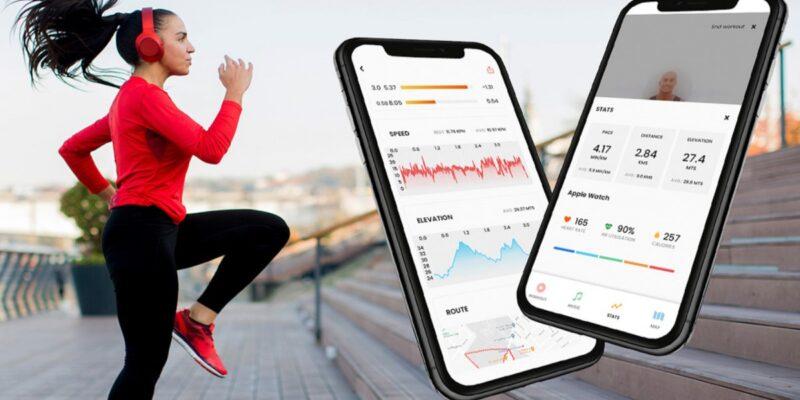Sport is a great way to combat these and other health problems. Fitness app development has become very popular in recent years.
Mobile apps are another modern trend. There are a thousand of them available for every aspect of life that you can imagine. Many things are made easier and better by technology. The same is true for sports. Sports culture has embraced smartphones and apps, while wearables have gained in popularity.
This article will show you how to create a fitness application. We have built many fitness apps and understand the latest trends. We would like to pass on our knowledge to you.
Why fitness apps?
Let’s take a look at the history behind fitness apps. Google Health was a promising service when it launched in 2008. It would be popular if it were launched now, but it was unpopular back then. The company had to abandon it in 2011 because it was not well received. Why did Google Health fail, despite the many possibilities?
In 2011, health was not a very popular topic. It was not a popular topic. In 2014, the fitness industry made a huge leap. Was the cause of this dramatic change? Wearables. Wearables became popular almost immediately.
Statista predicts that fitness apps that analyze fitness achievements such as weight lifting or distance running will only become more popular. The fitness market will grow significantly by 2021. Now is the time for startups who want to enter the industry. Let’s see what types of fitness applications you could build if you are already considering creating one.
Types of Fitness Apps
There are three main types of fitness applications. The difference between them is the way that they store and process the data.
-
Exercise and workout apps
-
Nutrition apps
-
Apps for tracking activity
Some applications fall into more than one category, while others are a mix of all three. Let’s examine each type in more detail.
Workout and exercise apps
The category Workout Apps is the largest on our list. They are primarily focused on exercises, as their name suggests. Its primary purpose is to explain how to perform exercises and show users exactly what to do.
Each app is unique. All workout apps can be divided into three categories:
-
Personal Trainers Apps
-
Logbook Apps
-
Apps for fitness workouts that work with your device
Let’s start by examining the first category.
Personal Trainer Apps
Apps like 6 Week Training and FitnessBuilder Plus are popular.
Here, the main idea is to provide an exercise complex that’s tailored for every user. The user can choose the level of difficulty and the exercises that they like.
Also, it’s important to demonstrate exactly how the exercises should be performed. Exercises can be harmful or have no effect if they are not done correctly. These applications allow users to avoid paying for a gym membership and instead use 3D models, videos, or detailed descriptions to learn how to do each exercise.
Logbooks Apps
These apps are minimalistic. These apps are a sort of to-do listing and store only information about your workouts. Logbook apps include HeavySet, Strong Fitbod and Stacked. Users can choose from a variety of preset libraries that include exercises.
Workout Fitness Apps that Pair with Devices
Apps for workouts are perfect for sports fans who cannot imagine working out without a fitness device or other wearable gadget. Wearable devices display all the data they collect on your smartphone.
These apps can also sync with sports equipment that is smart and come with an admin panel.
Nutrition Apps
They help users control their weight by counting calories and burning them, controlling water balance, and encouraging healthy eating habits. These applications can help users track how much they drink coffee and control their body fat percentage and weight.
These apps are primarily focused on setting personal goals. The app can help a person who has a hard time maintaining wholesome nutrition by creating grocery lists and collecting healthy food recipes.
Among the most popular applications are HealthyOut, Calorie Counter & Food Diary, and MyPlate Calorie Tracker.
Activity Tracking Apps
Even people who do not like sports or go to the gym can use activity-tracking apps to ensure they are moving enough. These apps can count steps and calories. Geolocation allows them to track the distance walked.
The most interesting feature is the sleep quality estimation. Smart alarm clocks can wake you up in the REM phase of sleep, allowing users to wake up faster.
Wearables can be used to track activity, but if you don’t own one then the capabilities of your smartphone will suffice.
Features of Fitness Apps:
It’s now time to learn what features are essential for any fitness application. We’ll then discuss the features specific to each type of fitness app.
Let’s start by looking at some statistics. What do people look for when installing a fitness application? Why do people install fitness apps?
Statista research shows that the most popular reasons for using these apps are:
As you can see from the above, fitness apps are used for three reasons: tracking goals, monitoring health issues, and keeping motivated. Some of the features that we will mention are crucial to success, as they allow users to get what they want from a quality app.
The industry is experienced in developing fitness apps. Multipurpose Fitness and Wellness Application, one of our projects is used to demonstrate many of the features below.
1. Create Accounts
Accounts are important because they enable users to store data and retain it even if they switch devices. No competition is possible without an account – but we’ll discuss competition later.
2. Integrating Other Services
Social networks are the easiest and fastest way to create an account on an app. Social logins allow users to see their friends that use the app, and they can publish their results. This increases motivation, as people can see the progress of their friends. It also encourages more people to download an app if they can see the achievements of their friends.
3. Add Personal Information
It is essential to be able to enter personal data because your app’s diet and workout programs must be adapted to the user’s height, weight, age, and other physical characteristics. People who care about their health will appreciate the ability to calculate workouts using personal data. Your fitness app should collect the following types of data:
-
Age
-
Gender
-
Height
-
Weight
Add profile photos to your application to personalize it. Don’t forget about offering measurements in imperial units, such as pounds, and feet, or metric units, such as kilograms, and meters. These units should be optional because users may be used to a different system. They might not understand feet if they’re used to meters.
4. Configuring Notifications
Motivation is a key factor in motivating people! Most people lose their initial enthusiasm for sports. There are many reasons why people skip exercise or abandon their diet. Apps can also be used to remind users of their exercise plans. Notifications must be able to be adjusted so that they do not become irritating – allow your users to set them as they wish.
5. Set Targets
All fitness apps must allow users to set goals. Crossfit apps must have workout targets, while activity trackers need targets for the number of steps taken or the hours slept. Diet apps may have targets such as calorie limitations or weight loss.
A target will help you stay motivated in any situation. The user must know what they are aiming for.
6. Setting
To make your app easy to use and customizable, you need settings. The settings menu should be simple and consistent, but comprehensive.
7. Gamification
Gamification can be used to both entertain and motivate. Competing with other users, rather than achieving achievements like those in video games, is better. Allow your users to compete, earn rewards, and compare their results with friends. Some applications, like Charity Miles, allow users to become a part of a charitable program by sharing their results on social media.
Features for workout apps
Pre-set Exercise Routines
This feature is only available in workout apps. Most workout apps have routines that cannot be modified. Users should be able to customize routines.
Live Streaming
It’s an optional feature, but worth exploring. Users can broadcast their workouts live and consult with professionals online while training.
Features for activity tracking apps
Integrate with Wearable Devices and Mobile Device Functions
If you want to support wearables, your app must be able to connect to as many trackers as possible. Apple’s HealthKit and Google Fit can be used for storage, while APIs from different wearable manufacturers (Up by Jawbone Garmin Withings Tomtom, and others) are available to connect the devices to your application.
Activity Tracking
HealthKit or Google Fit can be very useful in tracking walking, cycling, running, and swimming.
Geolocation
Geolocation is a must for any activity tracking app, as they are all about maps.
There are many maps available, including Google, Apple Tomtom, Waze, Tomtom, Waze, etc. Users can plan routes, track current locations, and record exercises. You can share screenshots of maps on social media.
Features for nutrition or diet apps
Food Logging
You should implement this feature. No diet app is complete without it. A product database and dictionary are essential for diet apps to allow users to easily log their information.
Barcode Scanner
The barcode scanner is an excellent feature that makes logging easier and faster. By scanning barcodes, users can quickly get the information they need about ingredients or calories by simply putting them in front of their smartphones.
Cost of Fitness App Development
You can’t know the exact cost of fitness app development. However, you can get a rough idea. Costs will vary depending on what features you choose, how long it takes to create the app, and the rate of the team that you hire.
This pie chart shows how much of the estimated development costs will be spent for each part of the process.
This is an estimate only. It depends on what you want. Sometimes, the design costs up to half or more of the total development costs. These figures may be different if you are looking to make a statement with a complex and stunning design. Estimating the design is one of the most difficult parts of a development process.
Estimates are also influenced by team size and development methods. Communication can also take a lot of time, especially if requirements aren’t very clear.
You should also be aware that in addition to the hours listed above, you will need approximately 18-34 hours for preparation. Production of the app takes between 4 and 12 hours.
You can then estimate the cost of developing your fitness application based on what you want and the hourly rates charged by your chosen developer team.
How to make money with your fitness app
There are many ways to monetize a fitness app. First, you can make your app available for free to the public and then charge a fee to access some of its features. It is very common to charge for advanced features in apps. Users get the basic functionality free, but they have to pay if they wish to use the full app.
Advertising in your app is another way to earn money, but you must be cautious. Users may be annoyed by ads and choose to use another app without them. Advertising isn’t the best way for a fitness application to be monetized because ads can be distracting and annoying.
Fitocracy, for example, charges users to use its workout apps with personal trainers.
Here are the top monetization methods for fitness apps.
1. Apps that are paid. Users pay a single fee to access all of the features in your app.
2. Freemium apps. Freemium apps offer the core functionality, but users can unlock more advanced features by paying a fee or subscribing to a premium edition.
3. Apps that offer in-app purchases Apps that offer virtual goods within the app. For example, customized training plans or diet plans.
4. Apps that have advertisements. You can earn money with this monetization method by putting ads into your app. These can be in the form of banners, pop-ups, or videos. It is the easiest way to monetize your app, but the user experience can be negatively affected.
Fitness Apps: The Best 5 Apps for 2023
Consider these 5 fitness apps before you create your fitness app.
-
My Fitness Pal. It has many different features. The app is ideal for people who want everything from an app.
-
Daily Workouts. Fitness Trainer. This app was created by a certified trainer who guides the user through their workouts. This is one of the best budget apps.
-
Glo. This app is ideal for yoga enthusiasts. The app offers daily classes that are curated to meet the needs of users.
-
Sworkit. The app is best suited for beginners. The app creates workouts automatically based on the time the user has to exercise.
-
The 7 Minute Workout. This app offers users basic workouts lasting seven minutes. This app is best for quick workouts.
Conclusion:
This article explains the features that are essential to different types of fitness apps. It’s not as simple as you may think to build a fitness application, but the rewards of launching one are worth it. Artoon Solutions has experience in building fitness applications and can provide the best development team and project managers for your fitness app.
Do not hesitate to contact Artoon Solutions if you would like more information. We offer excellent quality at an affordable price.



